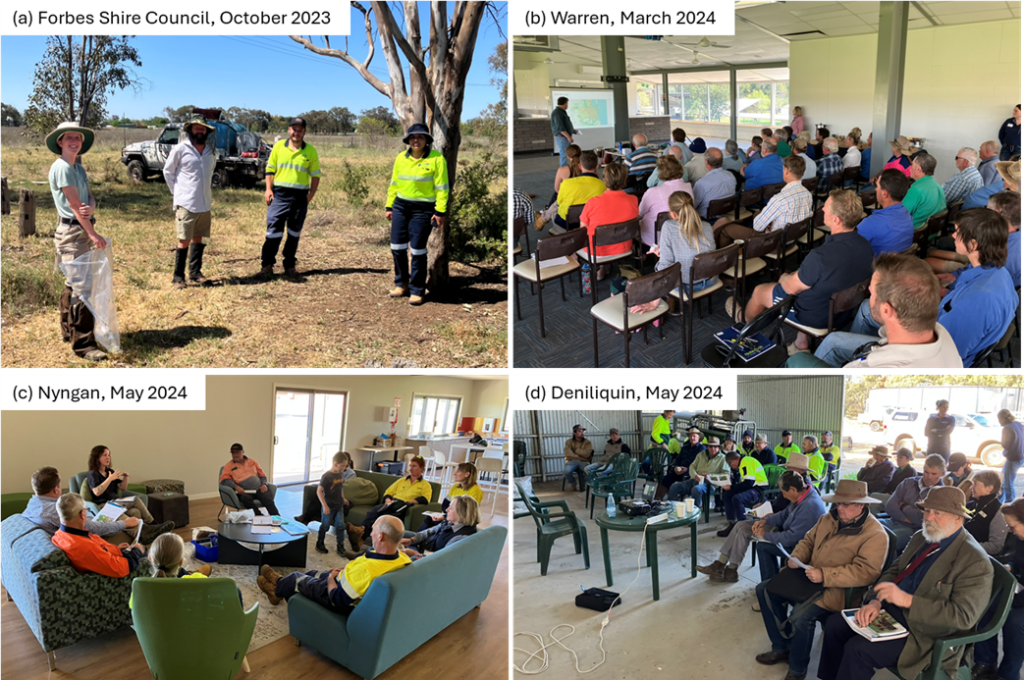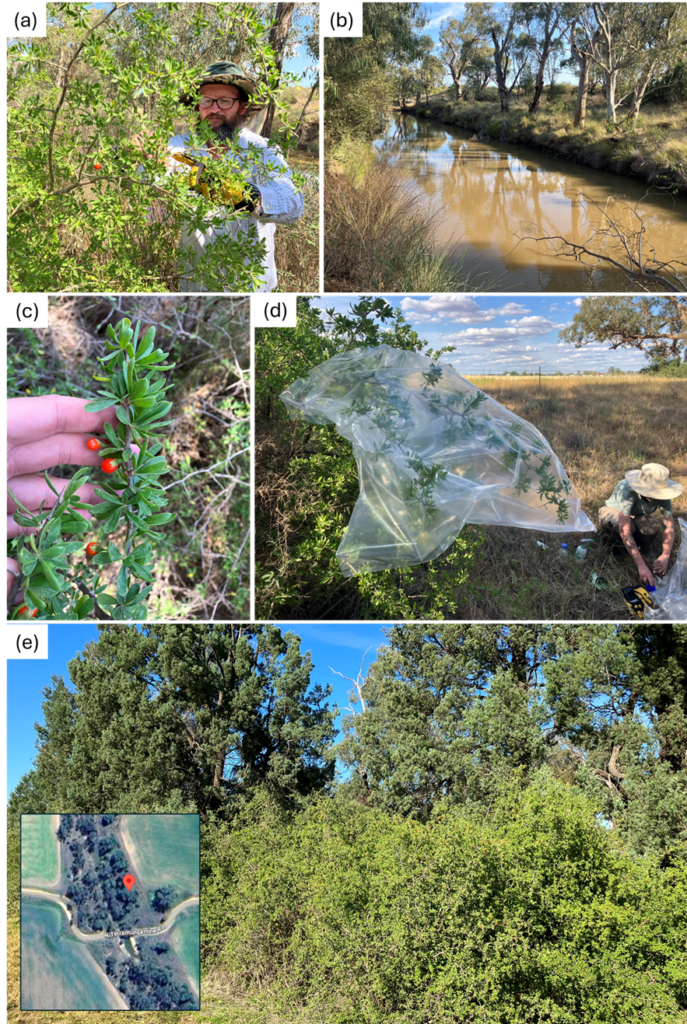NSW Environmental Trust (2023-26)
 This project commenced November 2023, with the aim to facilitate the mass-rearing, release, monitoring and evaluation of the impacts of the rust fungus (Puccinia rapipes) for the biological control of African boxthorn (Lycium ferocissimum) across NSW. For more information on our annual project updates, please scroll further down to the “Annual Update” heading.
This project commenced November 2023, with the aim to facilitate the mass-rearing, release, monitoring and evaluation of the impacts of the rust fungus (Puccinia rapipes) for the biological control of African boxthorn (Lycium ferocissimum) across NSW. For more information on our annual project updates, please scroll further down to the “Annual Update” heading.
This new project is proudly supported by the NSW Government through its Environmental Trust.
Project Overview
Output 1, monitoring and evaluation: The project will enable the establishment of a network of biocontrol agent release sites throughout NSW, in which the performance of the fungus and its effects on the target weed will be monitored regularly over time.
Output 2, community engagement: The project will also deliver the fungus and release instructions to key weed stakeholders across NSW, targeting areas where African boxthorn exerts the greatest threat to biodiversity values. Participants may include, but not limited to, Aboriginal and Torres Strait Islander peoples, biosecurity practitioners (e.g., council weed control officers), volunteer community groups (e.g., Landcare, Bushcare), Rangers (e.g., NPWS), private landholders and other key stakeholders with interests in African boxthorn biocontrol.
This project will include the following main activities:
- Maintain and mass-rear a healthy, viable culture of the biotrophic rust fungus:
- To be achieved under laboratory conditions on healthy, pest-free African boxthorn plants (based at the CSIRO Black Mountain Laboratories in Canberra, ACT).
- Deliver the fungus to registered stakeholders for release into the environment to help control African boxthorn infestations:
- It is proposed that the fungus will be delivered to up to 90 key stakeholders altogether over three years (resulting in release of the fungus at up to 260 sites). All stakeholders with interests in African boxthorn control are eligible to register interested in participating in the project, although there is no guarantee that all parties will receive the fungus if demand for participation is greater than our ability to culture the fungus in the laboratory.
- Establish up to 10 fixed African boxthorn monitoring sites throughout NSW:
- The CSIRO field ecologists will collect baseline weed population data at sites located across a broad climate gradient, with priority given to infestations located in grassy woodland communities in conservation reserves that are most under threat by African boxthorn invasion (especially along creeklines and other water sources).
- Release the fungus at the fixed monitoring sites under optimal climate conditions:
- Releases will preferentially be made during spring 2023, but summer releases will also be considered during periods of high rainfall (or high humidity) under moderate daytime temperatures (< 30°C).
- Monitor the performance of the fungus and its effects on the host African boxthorn plants at the fixed monitoring sites over time:
- The fungus will be released using optimised methods developed by CSIRO researchers. Post-release monitoring will be undertaken once every six months (or at least once per year) to evaluate establishment and spread of the fungus, disease incidence and severity on the host plants, and changes in the cover and condition of African boxthorn foliage in response to fungal infection.

Setting-up a site for monitoring the impact of the biocontrol agent on African boxthorn.
Eligibility to receive the biocontrol agent
The fungus is only available for release in NSW at this stage, as part of this current project supported by the NSW Environmental Trust, up until June 2026. Engagement will be targeted at community and public sector organisations, such as (but not limited to) Landcare, Local Land Services, NSW, Bushcare, local governments, other volunteer groups etc. Private landholders are also eligible to express an interest to participate in the program. The fungus is not commercialisable and cannot be released as part of for-profit ventures, including retail or as part of consultancies.
Please email Caroline Delaisse at boxthornbiocontrol@csiro.au to register your interest to participate in the biocontrol program. The CSIRO will endeavour to respond within one week of receiving the email. As part of the registration, the CSIRO will provide a pre-release assessment document for participants to complete, which requires information about the proposed location of the boxthorn infestation. The pre-release assessment needs to be undertaken prior to receiving the agent.
The biocontrol agent will be provided to registered participants at regular intervals between November 2023 and June 2026. The specific timing of delivery will be determined by prevailing climate conditions, quantity of available material for release and level of demand from registered participants.
The release kit will be sent via post. Participants should release the agent as soon as possible upon receiving their package. However, the spores of the biocontrol agent can be stored in the freezer for one month before preparing the biocontrol agent for release onto African boxthorn plants in the field if conditions at the time of receipt are unsuitable.
Additional documents
Registration document (for interested participants to fill in prior to receiving the biocontrol agent)
Release instructions on to release the biocontrol agent
Annual Update: November 2023 – December 2024
The project was officially launched in November 2024 with an announcement by the NSW Minister for the Environment, Penny Sharpe.
In an online article entitled “Rust is a must for African Boxthorn battle”, the CSIRO explains the aims and aspirations of the project, and how the community, public sector weed managers and conservation groups can get involved with releasing the rust fungus:
- Engage all stakeholders with interests in the control of African boxthorn in the biocontrol release program, including (but not limited to) private landholders, public sector land managers (e.g., LGA weed biosecurity officers), Landcare groups, etc. Engagement will occur through in-field demonstrations and workshops, online through annual email updates using the project account (boxthornbiocontrol@csiro.au) and printed information sheets.
- Distribute biocontrol agent release kits, along with release and monitoring instructions, to registered participants throughout NSW.
- Experimentally release the fungus at CSIRO-managed fixed monitoring plots, and evaluate the establishment, spread and impacts of the fungus on the host weed populations.
Workshops
Altogether, the CSIRO delivered 12 workshops during this first year, represented predominantly by Local Land Services, local governments and Landcare (see table below). The workshops were delivered to approx. 200 participants and consisted of a combination of presentations/seminars, in-field demonstrations of biocontrol agent release methods, and training in monitoring and evaluation techniques. Attendees were provided with printed copies of the presentation slide deck, program registration forms and the biocontrol agent release, monitoring and evaluation methods.
Information on the 10 workshops delivered for the African boxthorn biocontrol project.
|
Date |
Location |
Activity |
Partner organisation |
No. attendees |
|
9th October 2023 |
Dubbo |
Field demonstration of fungal release methods; training in monitoring and evaluation method |
Dubbo Regional Council |
2 |
|
11th October 2023 |
Forbes |
Field demonstration of fungal release methods; training in monitoring and evaluation method |
Forbes Shire Council |
5 |
|
27th November 2023 |
Hay |
Field demonstration of fungal release methods |
Hay Shire Council, Riverina Local Land Services |
2 |
|
22nd February 2024 |
Online |
Information session |
Hunter Local Land Services, Martindale Landcare |
5 |
|
6th March 2024 |
Warren |
Face-to-face seminar and field demonstration of fungal release methods |
Central West Local Land Services, Castlereagh Macquarie County Council |
~50 |
|
7th March 2024 |
Coonamble |
Face-to-face seminar and field demonstration of fungal release methods |
Central West Local Land Services, Castlereagh Macquarie County Council |
~50 |
|
13th May 2024 |
Nyngan |
Face-to-face seminar and field demonstration of fungal release methods |
Bogan Shire Council, Hilltops Council, Macquarie Valley and Lachlan Valley Weeds Committees |
~10 |
|
15th May 2024 |
Forbes |
Training in monitoring and evaluation methods |
Forbes Shire Council |
5 |
|
21st May 2024 |
Deniliquin |
Face-to-face seminar and field demonstration of fungal release methods |
Murray Local Land Services, Edward River Council |
~30 |
|
22nd May 2024 |
Hay |
Training in monitoring and evaluation methods |
Hay Shire Council, Riverina Local Land Services |
2 |
|
9th October 2024 |
Upper Hunter |
Face-to-face seminar and field demonstration of fungal release methods |
Hosted by Martindale Creek Catchment Landcare, supported by Hunter Local Land Services and Upper Hunter Weeds Authority |
~10 |
|
24th October 2024 |
Condobolin |
Face-to-face seminar and field demonstration of fungal release methods |
Central West Local Land Services |
~30 |

Representative photos of a subset of African boxthorn biocontrol workshops held in 2023-24.
Biocontrol agent delivery to community stakeholders
Since the program was launched, 170 community members have expressed interest in the program, of which 50 subsequently registered to receive and release the biocontrol agent into the environment. This included 35 private citizens and representatives from 11 regional councils, Landcare and Local Land Services. Altogether, the 50 participants have registered 98 sites at which the fungus will be/has been released at (see figure below).
Between December 2023 and August 2024, the CSIRO dispatched 102 biocontrol agent release kits to 33 of the registered participants, who to date have released the biocontrol agent at 41 sites using the approved methods.
The CSIRO will continue to register interested participants for ongoing releases of the fungus in autumn 2025. There remain significant gaps in the distribution of the fungus, especially in the Sydney Basin, Hunter, New England and Murray River. We invite participants from these regions to assist by releasing the fungus in autumn 2025.

Map of biocontrol agent release and monitoring and evaluation sites.
Monitoring plot establishment
In October and November 2023, the CSIRO set up 18 permanent monitoring sites at 9 localities and released the fungus at a subset of 16 of these sites. Sites were set up in dense infestations of African boxthorn in remnant native woodlands with an open Eucalyptus/Callitris canopy and understorey of mixed native/exotic perennial pastures (example photographs in figure below). We avoided heavily grazed areas that were disturbed by farm infrastructure or weed control activities. Sites were spread across a broad region of NSW, from the Central West, Southern Ranges, Riverina and Murray River.
At each site, up to 20 replicate African boxthorn plants were selected with each plant separated by ~2m. We selected plants that were reproductively mature with vigorous, lush and green foliage with no signs of physical damage or physiological stress.
Half of the plants were allocated to the fungal-inoculation treatment whilst an equal number of plants of similar size (height, diameter, foliage cover) were allocated to the non-inoculated control. For each plant, baseline measurements were taken on plant size (height, diameter) and foliage condition (% cover and the number of leaves, flowers and fruit on four 10-cm stem lengths selected at random per branch per plant).
Immediately prior to sunset, a single large branch on each of the fungal-inoculation treatment plants was sprayed liberally with a fungal spore suspension (inoculum was made up of 0.1ml spores in 250 ml 0.1% TWEEN 80; each branch was sprayed with 25 ml of inoculum), then covered in a clear plastic bag to maintain a humid environment overnight (see methods developed previously by the CSIRO: https://research.csiro.au/african-boxthorn/achievements-rrnd4p-rnd-2/). The bags were removed early the next morning at sunrise. The experimental control plants were sprayed with the same volume of solution (water mixed with Tween minus the fungal spores) and covered in plastic bags to control for the effects of bagging on foliage development.
Microclimate data (temperature and relative humidity) were recorded using 36 iButton dataloggers deployed at 18 release sites. Of the 36 deployed iButton dataloggers, data were retrieved from 14 iButtons from 11 release sites for the 2022/23 monitoring period. Microclimate variables were monitored hourly during the bagged releases (which were made between October-November 2023) and then for up to six-months (datalogger storage capacity) until the sites were monitored again in Autumn 2024. Of the 14 dataloggers, 11 dataloggers from 9 release sites recorded microclimate data during the bagged releases (note, 3 iButtons were missing data). Data revealed that the average temperature overnight during the inoculation event ranged between 10-20 °C across the 9 sites, and average relative humidity was > 90 % at 7 of the 9 sites. These microclimate ranges are suitable for germination of the fungal spores and infection of the host plants during 12 hr.
The microclimate data were then evaluated over the entire post-release monitoring period (Summer 2023 to Autumn 2024). In the Booroorban and Deniliquin region, releases were made in late November 2023 and monitored ~6 months later in late May 2024 whereas in Dubbo and Forbes, releases were made in mid-October 2023 and monitored ~7 months later in mid-May 2024. The data revealed that there was considerable variability in both temperature and relative humidity within each site over time, but altogether the average daily humidity was ~ 50 % and average daily temperature ranging from 20-30 °C. At all sites, average maximum daily temperatures over the entire recorded monitoring period were 30 °C or greater and regularly exceeded 40 °C during summer.

Example of monitoring site set up and biocontrol agent experimental release undertaken at Terramungamine (-32.11101, 148.469583): (a) selecting healthy African boxthorn plants (John Lester featured in photograph), (b) habitat context along Coolbaggie Creek, (c) 10-cm stem length on which number of leaves, flowers and fruit were recorded (4 per plant), (d) release of the fungus and bagging the inoculated branch, (e) habitat context.
Biocontrol agent establishment
In May 2024, approximately six months following the initial releases of the fungus, we returned to 12 of the monitoring sites to evaluate establishment of the fungus and its effects on the host plants. Visual symptoms of infection by the fungus (i.e., raised lesions on the leaf surface) were not detected on any of the inoculated plants at any of the release sites.
Microclimate data verified that the releases were made during optimal conditions for spore germination and infection of the host plants, and the host plants were healthy and suitable as hosts. We speculate that the very high average and maximum daily temperatures experienced at all sites within the first week following release, followed by sustained high temperatures and very low rainfall at most sites over summer, inhibited infection development by the fungus and establishment within the resident African boxthorn populations. We also received reports from several partner organisations that the very hot and dry temperatures resulted in broadscale defoliation and dormancy of the African boxthorn plants across each region. The rapid shedding of leaves and then subsequent regeneration of new leaves in autumn 2024 would likely have prevented us from detecting the fungus, even if initial infection was successful. As such, during the follow-up surveys in May 2024, we released the fungus a second time at a subset of six sites (Table 2).
When we returned to the plots in May 2024, we released the fungus a second time at 6 plots, using the same methods as described above. We returned to all plots again in October 2024. We observed spectacular results! The fungus was detected at high abundance and disease severity at 100 % of the plots where it was released a second time in May 2024 (see photos below). This suggests that there are strong seasonal effects on establishment of the fungus, and that autumn is a more optimal time of the year to release it into the field. At these sites, we also detected the fungus on nearby plants that were not originally inoculated, meaning the fungus has begun spreading in the local environment.
Follow-up surveys in 2025 will allow us to determine how quickly the fungus can spread and indeed whether it is able to persist in the local environment over summer. We expect that such persistence is likely, given we found the fungus at very density at 17 % of sites where it was only released once in 2023.

African boxthorn infection at various NSW monitoring plots set up by CSIRO.
Impacts of the fungus on African boxthorn populations
So far, infection by the fungus, including in areas with high disease severity, has not resulted in significant decline in the foliage cover of the host weed. This is expected, as biocontrol agents will only exert significant impacts on the host weed once they have become well established in the environment at high density and spread widely across the landscape. Even for some of Australia’s most successful biocontrol projects, benefits through reduced weed abundance are realised over years to decades. As the rust fungus is not a bioherbicide, it is not expected that infection will result in defoliation of African boxthorn following its release. As such, the primary aim of this project is to widely release the fungus across NSW and get it well-established in the NSW environment, sustained over time. Ongoing research on African boxthorn foliage, reproductive output and populations in response to infection by the fungus will, in time, reveal its impacts on the host plant. For now, the fact that we have been able to induce infection on naturalised populations of Africa boxthorn in the field for at least one year is considered a resounding short-term success
